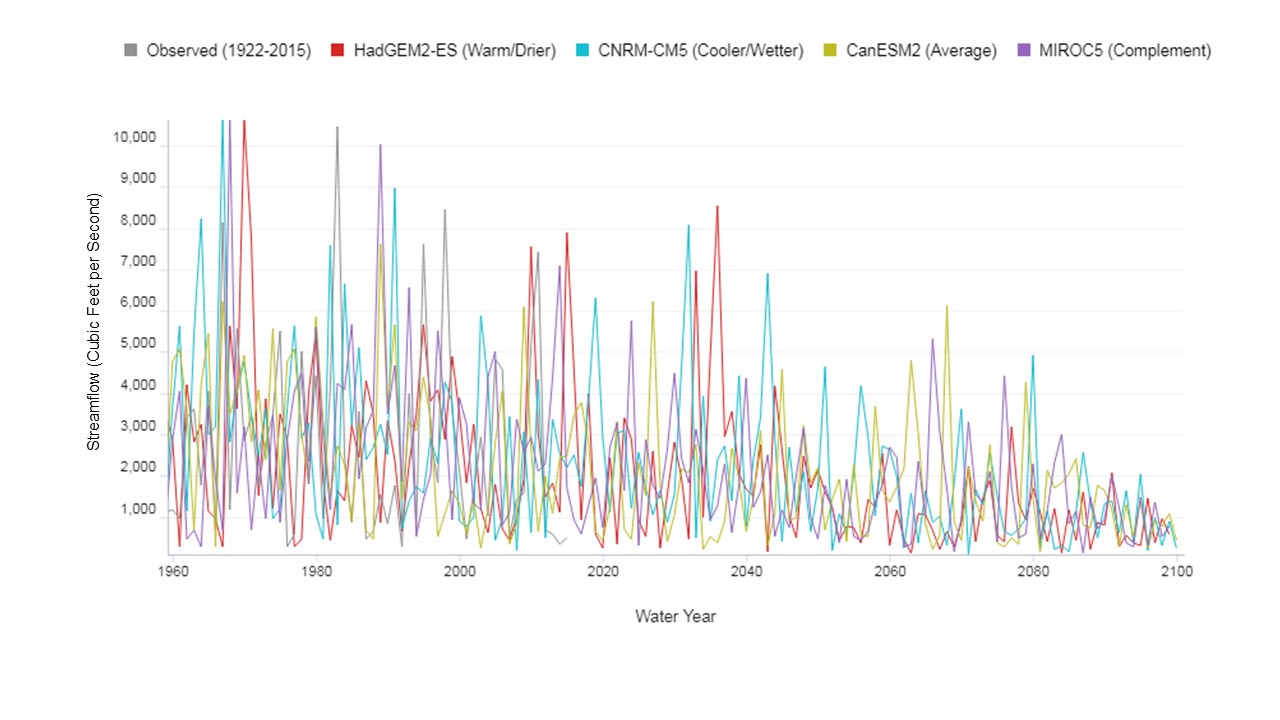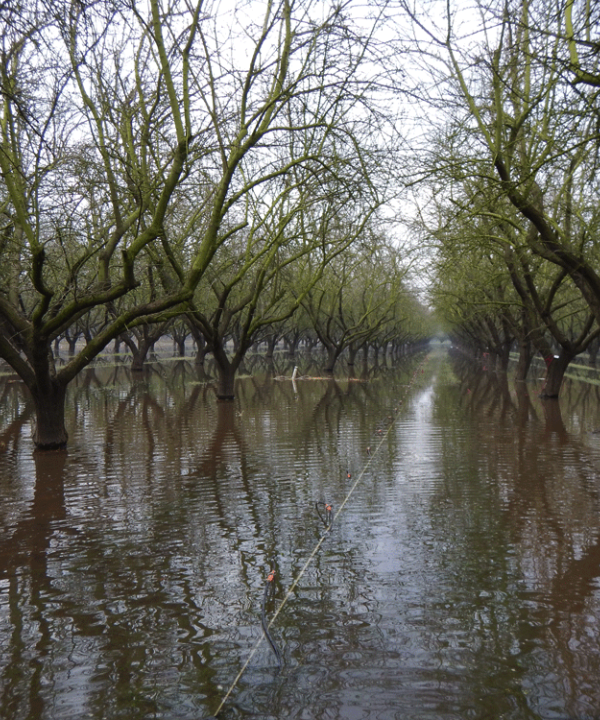February 11, 2019 | Water in the West and Union of Concerned Scientists | Insights
Climate change is fundamentally transforming the way we manage water in the Western U.S. The recent Fourth California Climate Change Assessment lays out the many pressures facing water managers in California in detail. One key take-away of that Assessment is that past climate conditions will not be a good proxy for the state’s water future, and smarter strategies are needed to manage California’s water. Just one-third of the snowpack that the state has historically relied on as a natural water reservoir is projected to remain by 2100; hotter temperatures will dry out soils faster and earlier in the year; and the atmospheric rivers that already cause intense flooding in the state will likely carry more moisture as the atmosphere warms. All of this will require a transformation in the way that we, here in California and elsewhere, plan for our water future.
Luckily, the science available to us today creates opportunities for water managers and others to plan for changing climatic conditions. California has traditionally relied on historical data to make inferences about future water supply and flood planning. However, climate change is changing our physical system so dramatically that historical data can no longer be used to make accurate predictions about the amount of snowfall, the duration, intensity and frequency of droughts or floods and many other climate conditions that affect our water resources. New data released by Cal-Adapt as part of the Fourth California Climate Change Assessment (Figure 1) provides higher spatial resolution climate projections to better estimate future climate change and extreme events. Incorporating these data, and data like it, into water management planning is likely to significantly improve public agencies’ ability to plan for changes in water supply and demand, drought and floods. Making sure that these data are incorporated, interpreted and used according to the best available science, though, will be vital to ensuring that water managers get the most benefits from preparing for climate change.

Figure 1. Data from Cal-Adapt shows reductions in June streamflow in the Stanislaus River projected through the 21st century by climate models. Source: Cal-Adapt.
In this blog, we’re going to walk through some best practices for climate planning in the context of managing one of California’s most important water systems: its groundwater. This builds off of our 2017 whitepaper, “Navigating a Flood of Information: Evaluating and Integrating Climate Science into Groundwater Planning in California”, published by the Union of Concerned Scientists and Stanford’s Water in the West program. With the deadline just under a year away for submission of the first round of groundwater management plans under California’s landmark Sustainable Groundwater Management Act (SGMA), many water managers are grappling with how to incorporate climate science into groundwater management planning.
Climate Change in California’s Sustainable Groundwater Management Act

Governor Jerry Brown signed the Sustainable Groundwater Management Act into law in September 2014. Source: California Department of Water Resources
SGMA, passed by the California legislature in 2014, provides a key opportunity for incorporating climate change into water planning. Not only does groundwater serve as a “buffer” during dry times, groundwater aquifers can store huge volumes of water during floods, which is increasingly important as California experiences more extreme climate events. SGMA provides a statewide framework that incentivizes the flexible management of groundwater basins, in part because it recognizes the impacts that climate change will have on water management in California and requires water managers to incorporate these impacts.
Climate change is incorporated into SGMA both explicitly and implicitly. Explicitly, SGMA requires the local agencies managing groundwater, known as Groundwater Sustainability Agencies (GSAs), to incorporate quantitative climate change assessments into projected water budgets using a numerical groundwater and surface water model or an “equally effective method, tool, or analytical model” (23 California Code of Regulations (CCR) 23 §§ 345.18(c)(3) and 345.18(e)). Climate change is also implicitly present in the definition of groundwater sustainability in the legislation, which requires groundwater management to be sustainable over a 50-year planning and implementation horizon (California Water Code (CWC) § 10727.2(c)). Over this 50-year window, climate change will continue to transform the conditions under which GSAs are operating. Consequently, GSAs that are unable to incorporate climate change analyses into their planning decisions and adapt their decisions through time are likely to find themselves underprepared.
These legislative requirements create an opportunity for GSAs to understand and incorporate climate change into their Groundwater Sustainability Plans (GSPs) in a way that ensures that their basin is resilient to the increasing water instability of the future. This process is a challenging one though. An analysis of the 18 Alternative Plans submitted to the Department of Water Resources under SGMA highlights some of the challenges of incorporating climate change into the planning process. Eleven plans incorporate climate change quantitatively. However, the majority of these (6) focus on a single aspect of climate change (Figure 2). For example, multiple plans focus on sea level rise, but don’t consider other climatic variables, like changing water supply, water demand and hydrology, as required under SGMA. Five plans have no mention of climate change.

Figure 2. Summary of climate change analyses in Alternative Plans for groundwater sustainability submitted to the California Department of Water Resources under the 2015 Sustainable Groundwater Management Act.
These preliminary numbers indicate that agencies managing groundwater do not perceive the risks of climate change equally nor do they take a consistent approach to integrating climate information into the planning process. Additionally, this analysis of Alternative Plans highlights the disconnect between the climate analysis that is being done and the actual management actions that will help protect groundwater resources against climate risk. GSAs recognize that climate change is an issue for sustainable management in their respective basins, but are struggling to identify how to incorporate it meaningfully into their planning process.
Helping agencies to integrate climate change into their Groundwater Sustainability Plans
One thing has become clear during SGMA implementation – each groundwater basin subject to SGMA has a different approach to sustainability, informed by local conditions, data, resources and a host of other factors. Thus, each GSA will achieve groundwater sustainability through implementation of a unique set of projects and management actions. For example, many basins are currently developing additional recharge capacity and investigating conservation programs to bolster supply and limit overall demand, respectively. Tailoring climate analysis to individual management actions will ensure that the hard work and investment of planning these actions will deliver the desired benefits in the long run.
In our 2017 whitepaper, we lay out an evaluation framework designed to help GSAs do this. The framework walks GSAs through four main steps (Figure 3):
- Determine management objective(s). The first step an agency should take is to decide their management objectives – for example, initiatives like conservation targets, developing new water sources or investing in increased recharge. This information will inform the type of climate analysis necessary to support the objectives.
- Evaluate existing climate change information. The second step is to understand the available climate data. The framework provides information to help agencies understand the components of climate data, assess whether the available data is appropriate for their management objectives and identify gaps that may require new data or analysis.
- Select appropriate climate change information. The third step is to connect an agency’s management objectives with the information gathered about the available climate data. Connecting management objectives with climate data allows management agencies to select the data and analysis appropriate for their application. For example, agencies will want to consider whether the available climate data and proposed analysis match the level of risk tolerance that is appropriate for a particular application and whether they capture the relevant impacts of climate change.
- Stress test management objectives. This final step ensures that agencies understand the climate conditions that might cause their management objectives to fail, so that they understand the likelihood and potential warning signs of failure and can plan accordingly.

Figure 3. A framework for integrating climate change analysis into groundwater management planning (adapted from Christian-Smith et al. 2017).
Tailoring climate change information to the management objective
The core question in any climate change analysis should be, “Is the analysis being conducted commensurate with the risk, cost, lifespan, etc. of the water management activity or project being undertaken?” Management strategies that can be readily adapted and with minimal overhead costs may not require extensive climate change analysis. However, high-risk, high-cost infrastructure projects that cannot be readily adapted to changing climatic conditions likely warrant a thorough climate change analysis. Going through the thought process laid out above will allow water managers to ensure that the climate analysis they conduct is appropriate to the water management actions being undertaken in their basin.
To demonstrate why agencies need to tailor their use of climate change information to the management objective at hand, we provide two examples of management actions that a GSA might pursue to achieve groundwater sustainability: developing a conservation target and building a recharge basin.
A management action like a conservation target – for example, a basin aiming to reduce water consumption by 25% over the next 20 years – is fairly flexible. The effectiveness of the target is most likely to be affected by annual-average basin conditions, rather than particular types of short-term extreme climate events. The target can also be adapted as conditions change. For this type of project, median climate changes to the annual average water budget will likely provide a sufficient picture of how climate change is likely to affect the effectiveness of the target. Even for a flexible management action like a conservation target, it may be useful for an agency to “stress test” how its planned target would need to be modified in the face of an extreme climate change scenario. Doing so would provide an agency with sufficient information to communicate to stakeholders and to develop contingency plans to adapt to extreme conditions before they occur.

The delivery point for the Coachella Valley Water District’s Thomas E. Level Groundwater Replenishment Facility. Source: California Department of Water Resources.
A management action like building a new recharge basin, meanwhile, requires extensive planning, permitting labor and capital costs. Once decisions about project conveyance, location and capacity have been made, they can be difficult to modify without substantial additional costs. Recharge facilities are also impacted by different aspects of climate change than conservation targets or other management actions. The effectiveness of a recharge basin, relying on diverted, excess floodwaters to recharge a groundwater aquifer, will depend on the frequency, location and volume of extreme floodwater events. Understanding how extreme floodwater events are likely to change over a project’s 50-year lifespan may significantly alter a project’s design specifications or overall value. This assessment requires information on how climate change will affect maximum daily rainfall, runoff rates and other climatic variables, rather than annual average rainfall. The relative inflexibility of built projects, like recharge basins, also makes it even more important to assess how the project would behave in the face of the most extreme types of these events under the most extreme climate change conditions to avoid costly failures or obsolescence.
What should agencies know about climate change data?
As the examples above show, tailoring climate change information to the management objective is crucial for getting the benefits of smart climate planning. But this requires an understanding of how that information is generated and what it contains, as we lay out in detail our whitepaper.
Most of the information and data about future climate conditions that basins are likely to face comes from the climate projections generated by global climate models, which are essentially numerical representations of the physics of the climate system. To produce future climate projections, models use scenarios of what future climate-warming emissions could be. Because we don’t know what choices society will make that could impact greenhouse gas emissions, a range of possible future emissions scenarios are used. Some of these scenarios generate more severe climate change and some of them generate less severe climate change.
The future climate projection data that comes out of the model will have a certain spatial resolution – the grids of climate model outputs are analogous to pixels composing an image – as well as a characteristic time frequency (e.g. hourly, annually or monthly) at which the future climate conditions are provided.
When the data comes out of the global climate model, its gridding is at a much larger scale (e.g. 12 grid boxes for the whole state of California) than what a basin-wide or even state-wide hydrological model would need. Translation between these different grid sizes is done through a process called downscaling (i.e. scaling down the grid of the global climate model to be compatible with the grid of the hydrological model). Downscaling can be done in different ways, each of which introduces different biases into the projected climate conditions that will eventually serve as inputs for hydrological models.
As GSAs evaluate and select their climate information for a particular application, here are some of the questions they might ask:
- What is the spatial resolution of the climate data? Is it sufficient for my application or objective? Does it tell me enough about my basin to make informed decisions?
- What downscaling technique has been used? Does it retain the type of climate impacts from the original climate model projection that matter for my management objective?
- What climate variables, such as precipitation or temperature, are included? Do they capture the aspects of climate change that matter for my management objective?
- What future emissions scenarios are used to generate the climate data? Do they span the range of potential climate change severity that matches the risk tolerance appropriate for my use?
- How are uncertainties captured? Am I sampling an adequate range of climate models to capture the ways that climate change might evolve in response to a given future emissions scenario?
- How will the climate data be incorporated into hydrologic models? Is the hydrologic model designed to incorporate all of the aspects of the climate data that I care about?
Asking these questions, although they may require grappling with new concepts, will help water managers to get the greatest benefits from their climate planning. Our whitepaper provides additional background on interpreting and selecting climate data and on best practices for incorporating climate change into sustainable groundwater management.
Getting the most out of climate change planning
Understanding and incorporating climate science into water planning can help water managers make the most of changing conditions. Doing so, however, will require water managers and climate scientists to work together to understand water management objectives and to tailor climate data to those objectives. Before investing in costly infrastructure projects and management actions, GSAs should think carefully about how the information gained from their climate analysis will influence their management decisions. Additionally, climate change analysis should be commensurate with a management action’s risk, cost and lifespan. As climate change progresses and our understanding of the science and risks increases, building flexibility and iteration into the planning process will also provide benefits. At the end of the day, climate change planning needs to be incorporated not only into water budgets but also into individual management actions to ensure their resilience and long-term viability. Doing so, will help ensure that water management agencies are developing actions and projects that will continue to provide vital water resources to Californians in our changing climate future.

This blog was a joint effort by Tara Moran from Stanford's Water in the West Program and Geeta Persad from Union of Concerned Scientists. This blog post can also be found on the website for the Union of Concerned Scientists.


![[Woods Logo]](/sites/default/files/logos/footer-logo-woods.png)
![[Bill Lane Center Logo]](/sites/default/files/logos/footer-logo-billlane.png)